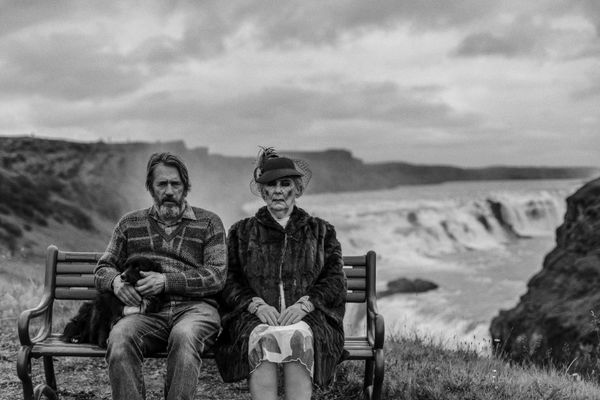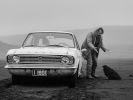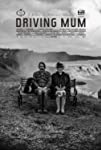Eye For Film >> Movies >> Driving Mum (2022) Film Review
Driving Mum
Reviewed by: Amber Wilkinson

There’s a heightened sense of the absurd in Hilmar Odsson’s Driving Mum, which will take us on an Icelandic odyssey - with the emphasis on ‘odd’ - in crisply shot monochrome.
Jón (Thröstur Leó Gunnarsson) and his mum (Kristbjörg Kjeld). It’s 1980 and the pair spend their days in their isolated croft with their dog Bresneff (pronounced Brezhnev), knitting jumpers and listening to the radio which, in the first hint of the absurdity to come, has been recorded for them onto cassette tapes. When his mother labours a promise that he makes to her about taking her to Eyrabakki when she dies, we know it’s only a matter of time before circumstances are going to call on him to make good on it.

Rather than put her in a box for the journey, however, Jón decides to fulfill a few of her additional wishes along the way and, in order to do that, sticks her make-up on her and lashes her to the backseat of the car. The humour of much of the film stems from the fact that this act is treated as matter-of-factly as any sort of road trip would be. Just because mum is dead doesn’t mean she’s about to stay quiet, piping up with directions and acidic comments from the rear of the car at key moments. In another running joke, almost everyone they encounter assumes she is alive, even when Jón points out the truth.
As with most road trips, Oddson’s comedy is as much about the emotional journey that will be made by Jón as he ventures forth into the world and reconnects not just with that but also with an episode from his past. Jón is a keen photographer and Odsson takes his approach from that cue. He represents the trip as a series of snapshots that are punctuated by a theatrical troupe who seem to flit between the physical reality of the island and Jón’s psychological experience, not least because one of them reminds him of a lost love.
Oddson maintains a melancholy mood and finds ways to shift his narrative from everyday absurdity to full-on surreality and back again, helped enormously by the score from Estonian composer Tõnu Kõrvits. In places, he brings the feel of the bluesy American south, or a violin theme that recalls a journey by horseback, in others otherworldly choral notes hold sway.
This matches the oddness of Jón’s experience, including an encounter with two unstoppably flirtatious women in a bar which sees him manage to pull by accident and a stand-off with a van full of German tourists is played for visual laughs. There’s also room for more poetic dalliances, as the troupe arrive in what may, or may not, be a dream sequence out of the mist after Jón’s car breaks down. Meanwhile a scene in which he and a tourist (Tómas Lemarquis) hold a conversation in two separate languages is worked for both humour and poignancy. Cinematographer Óttar Guðnason captures the film with measured and balanced framing whose very calmness and regularity also emphasises the oddness of the humour on display.
Bresneff - played with the sort of comic timing any two-legged actor would be proud of by Dreki (Dragon) - steals every scene he is in and acts a sounding board for Jón as he unexpectedly finds himself navigating shifting emotions as well as Iceland’s changing landscape. It may not be drawing any profound conclusions about life in general but as an evocation of one man’s experience, it’s quite a trip.
Reviewed on: 21 Nov 2022
















